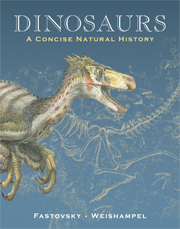Book contents
- Frontmatter
- Contents
- Why a natural history of dinosaurs?
- Dedication
- Part I Reaching back in time
- 1 To catch a dinosaur
- 2 Dinosaur days
- 3 Who's related to whom – and how do we know?
- 4 Who are the dinosaurs?
- Part II Ornithischia: armored, horned, and duck-billed dinosaurs
- Part III Saurischia: meat, might, and magnitude
- Part IV Endothermy, endemism, and extinction
- Glossary
- Figure credits
- Index of subjects
- Index of genera
4 - Who are the dinosaurs?
- Frontmatter
- Contents
- Why a natural history of dinosaurs?
- Dedication
- Part I Reaching back in time
- 1 To catch a dinosaur
- 2 Dinosaur days
- 3 Who's related to whom – and how do we know?
- 4 Who are the dinosaurs?
- Part II Ornithischia: armored, horned, and duck-billed dinosaurs
- Part III Saurischia: meat, might, and magnitude
- Part IV Endothermy, endemism, and extinction
- Glossary
- Figure credits
- Index of subjects
- Index of genera
Summary
Chapter objectives
Learn basic relationships among tetrapods – particularly amniotes
Understand something about the course of tetrapod evolution
Learn who dinosaurs are (and are not)
Become familiar with the characters that diagnose Dinosauria
Finding the history of life
In the preceding chapter, we explored the methods that scientists use to learn the identity and origin of all organisms. Now we will apply those techniques – diagnostic characters hierarchically distributed on cladograms – to properly position dinosaurs within the biota. The history of life will unfold as we systematically encounter each bifurcation in the cladistic road, reconstructing the path of evolution until we reach Dinosauria. We will be looking at increasingly small subgroups, each characterized by a suite of diagnostic characters. The appearance of each of those suites of diagnostic characters represents new features, forged by evolutionary processes. We'll go with Glinda the Good Witch's suggestion that “it's always best to start at the beginning.”
In the beginning
Modern life is generally understood to be monophyletic. It's united by the possession of RNA, DNA, cell membranes with distinctive chemical structure, a variety of amino acids (proteins), the metabolic pathways (that is, chemical reaction steps) for their processing, and the ability to replicate itself (not simply grow). Notice we said “modern” life – for who knows how many forms of molecular life arose, proliferated, and died out very early in Earth's history – before the thing that we now call “life” finally prevailed?
- Type
- Chapter
- Information
- DinosaursA Concise Natural History, pp. 50 - 73Publisher: Cambridge University PressPrint publication year: 2009

